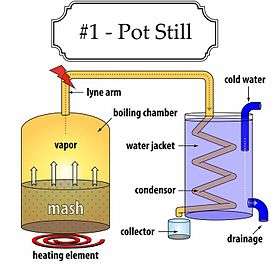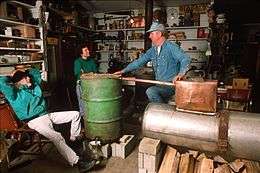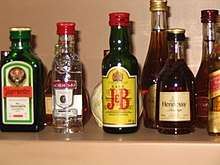Moonshine

Moonshine was originally a slang term for high-proof distilled spirits usually produced illicitly, without government authorization.[1] In recent years, however, moonshine has been legalized in various countries and has become a commercial product.
Legal in the United States since 2010, moonshine is defined as "clear, unaged whiskey",[2] typically made with corn mash as its main ingredient.[3] Liquor-control laws in the United States always applied to moonshine, with efforts accelerated during the total ban on alcohol production mandated under the 18th Amendment of the Constitution. Since its repeal, and moonshine's recent legalization, they focus on evasion of revenue taxation on spiritous or intoxicating liquors. Applicable laws are enforced by the Bureau of Alcohol, Tobacco, Firearms and Explosives of the US Department of Justice, once known colloquially as "revenooers".
Terminology
Moonshine is known by many nicknames, including white liquor, white lightning, mountain dew, choop, hooch, homebrew, ‘"shinney"’, white whiskey, and mash liquor.
History
Etymology
The word "moonshine" is believed to be derived from the term "moonrakers" used for early English smugglers and the clandestine nature of the operations of the illegal Appalachian distillers who produced and distributed whiskey.[4][5]
Process
When illegal in the United States, moonshine distillation was done at night to avoid discovery.[6] Moonshine was especially important to the Appalachian area. This white whiskey most likely entered the Appalachian region in the late 18th century to early 1800s. Scots-Irish immigrants from the province of Ulster in the north of Ireland brought their recipe for uisce beatha, Gaelic for "water of life". The settlers made their whiskey without aging it, and this is the same recipe that became traditional in the Appalachian area.[7]
In the early 20th century, moonshine became a key source of income for many Appalachian residents like Marvin "Popcorn" Sutton, since the limited road network made it difficult and expensive to transport corn crops. As a study of farmers in Cocke County, Tennessee, observes: "One could transport much more value in corn if it was first converted to whiskey. One horse could haul ten times more value on its back in whiskey than in corn."[8] Moonshiners in Harlan County, Kentucky, like Maggie Bailey, made the whiskey to sell in order to provide for their families.[9] Others, like Amos Owens, from Rutherford County, North Carolina and "Popcorn" Sutton from Maggie Valley, North Carolina sold moonshine to nearby areas.

Marvin "Popcorn" Sutton's life was covered in a documentary on the Discovery Channel called "Moonshiners". The legendary bootlegger once said that the malt (a combination of corn, barley, rye) is what makes the basic moonshine recipe[10] work. In modern usage, the term "moonshine" ordinarily implies that the liquor is produced illegally; however, the term has also been used on the labels of some legal products as a way of marketing them as providing a similar drinking experience as found with illegal liquor.
Safety
Poorly produced moonshine can be contaminated, mainly from materials used in the construction of the still. Stills employing automotive radiators as condensers are particularly dangerous; in some cases, glycol, products from antifreeze, can appear as well. Radiators used as condensers also may contain lead at the connections to the plumbing. These methods often resulted in blindness or lead poisoning[11] for those consuming tainted liquor.[12] This was an issue during Prohibition when many died from ingesting unhealthy substances. Consumption of lead-tainted moonshine is an important risk factor for saturnine gout, which is a very painful but treatable medical condition that damages the kidneys and joints.[13]
Although methanol is not produced in toxic amounts by fermentation of sugars from grain starches,[14] contamination is still possible by unscrupulous distillers using cheap methanol to increase the apparent strength of the product. Moonshine can be made both more palatable and less damaging by discarding the "foreshot"—the first few ounces of alcohol that drip from the condenser. Because methanol vaporizes at a lower temperature than ethanol it is commonly believed that the foreshot contains most of the methanol, if any, from the mash. Research shows that this is not the case and that methanol will be present until the very end of the distillation run. But the foreshot does typically contain small amounts of other undesirable compounds such as acetone and various aldehydes.
Alcohol concentrations at higher strengths (the GHS identifies concentrations above 24% ABV as dangerous[15]) are flammable and therefore dangerous to handle. This is especially true during the distilling process when vaporized alcohol may accumulate in the air to dangerous concentrations if adequate ventilation has not been provided.

Tests
A quick estimate of the alcoholic strength, or proof, of the distillate (the ratio of alcohol to water) is often achieved by shaking a clear container of the distillate. Large bubbles with a short duration indicate a higher alcohol content, while smaller bubbles that disappear more slowly indicate lower alcohol content.
A more reliable method is to use an alcoholmeter or hydrometer. A hydrometer is used during and after the fermentation process to determine the potential alcohol percent of the moonshine, whereas an alcoholmeter is used after the product has been distilled to determine the volume percent or proof.[16]
A common folk test for the quality of moonshine was to pour a small quantity of it into a spoon and set it on fire. The theory was that a safe distillate burns with a blue flame, but a tainted distillate burns with a yellow flame. Practitioners of this simple test also held that if a radiator coil had been used as a condenser, then there would be lead in the distillate, which would give a reddish flame. This led to the mnemonic, "Lead burns red and makes you dead." or "Red means dead."[17]
Prevalence
Varieties of moonshine are produced throughout the world.
See also
References
- ↑ "What Is Moonshine? Is Moonshine Illegal? – The Famous Illegal Drink of Yore". Flasks.com. 2013-08-27. Retrieved 2015-05-04.
- ↑ "Exploding moonshine: The new golden age of outlaw liquor". Retrieved 2017-07-02.
- ↑ Guy Logsdon, Oklahoma Historical Society. "Moonshine". Encyclopedia of Oklahoma History & Culture. Oklahoma State University. Archived from the original on 2014-10-31. Retrieved 21 March 2014.
- ↑ Ellison, Betty Boles (2003). Illegal Odyssey: 200 Years of Kentucky Moonshine. IN: Author House. p. 1. ISBN 978-1-4107-8407-0.
- ↑ Kellner, Esther (1971). Moonshine: its history and folklore. IN: Bobbs-Merrill. p. 5. ISBN 978-0517169667.
- ↑ Jason Sumich. "It's All Legal Until You Get Caught: Moonshining in the Southern Appalachians". Appalachian State University. Retrieved 21 March 2014.
- ↑ Joyce, Jamie (2014). Moonshine: A Cultural History of America's Infamous Liquor. Minneapolis: Zenith. pp. 8–14. ISBN 978-0-7603-4584-9.
- ↑ Peine & Schafft 2012, pp. 98–99.
- ↑ Block, Melissa (2005-12-08). "'Queen of the Mountain Bootleggers' Maggie Bailey". National Public Radio. Retrieved 2015-05-04.
- ↑ "Popcorn Sutton Moonshine Recipe". Whiskey Still Company.
- ↑ "Why Your Copper Moonshine Still Needs To Be Lead Free – Whiskey Still Company".
- ↑ Peine & Schafft 2012, p. 97.
- ↑ Dalvi, Sam R.; Pillinger, Michael H. (May 2013). "Saturnine gout, redux: a review". The American Journal of Medicine. 126 (5): 450.e1–8. doi:10.1016/j.amjmed.2012.09.015. ISSN 1555-7162. PMID 23510947.
- ↑ "Distillation: Some Purity Considerations". Moonshine Still. Retrieved 2015-05-05.
- ↑ "Hazardous Goods Management". Retrieved 2017-08-31.
- ↑ "Alcoholmeter or Hydrometer: Do You Know the Difference?". Retrieved 2014-10-28.
- ↑ "Moonshine". Skylark Medical Clinic. Archived from the original on 2011-07-16. Retrieved 2008-07-23.
Sources
- Davis, Elaine. Minnesota 13: "Wet" Wild Prohibition Days (2007) ISBN 9780979801709
- Peine, Emelie K.; Schafft, Kai A. (Spring–Fall 2012). "Moonshine, Mountaineers, and Modernity: Distilling Cultural History in the Southern Appalachian Mountains". Journal of Appalachian Studies. Appalachian Studies Association. 18: 93–112. JSTOR 23337709.
- Rowley, Matthew. Moonshine! History, songs, stories, and how-tos (2007) ISBN 9781579906481
- Watman, Max. Chasing the White Dog: An Amateur Outlaw's Adventures in Moonshine (2010) ISBN 9781439170243
- King, Jeff. The Home Distiller's Workbook: Your Guide to Making Moonshine, Whisky, Vodka, Rum and So Much More! (2012) ISBN 9781469989396
External links
- "Moonshine – Blue Ridge Style" An Exhibition Produced by the Blue Ridge Institute and the Museum of Ferrum College
- Déantús an Phoitín (Poteen Making), by Mac Dara Ó Curraidhín (a one-hour 1998 Irish documentary film on the origins of the craft).
- North Carolina Moonshine – Historical information, images, music, and film excerpts
- Moonshine news page – Alcohol and Drugs History Society
- Georgia Moonshine – History and folk traditions in Georgia, USA
- "Moonshine 'tempts new generation'" – BBC on distilling illegal liquor in the 21st century.
- Moonshine Franklin Co Virginia Moonshine Still from the past – Video
- Dangers of Drinking Homemade Moonshine Video about the dangers of drinking moonshine


